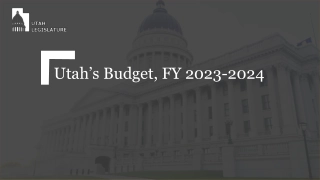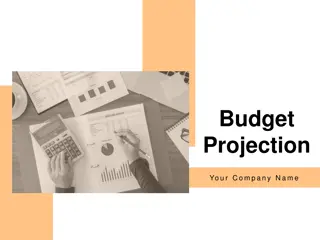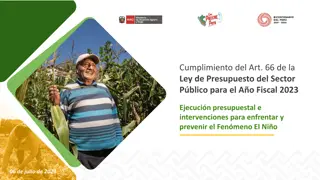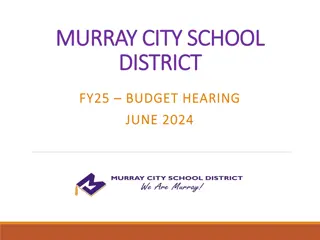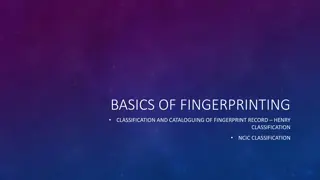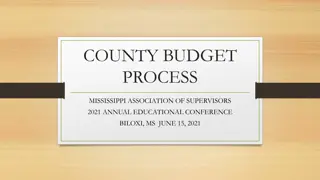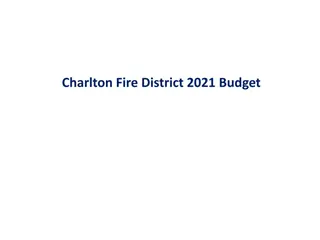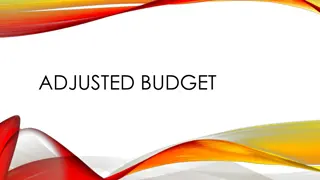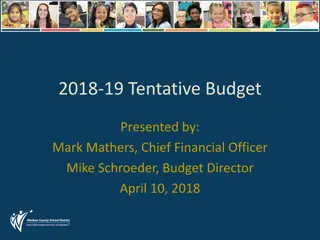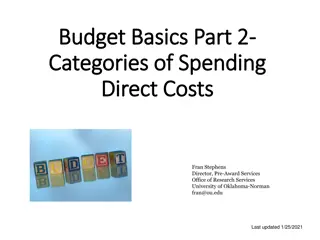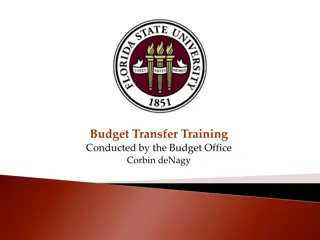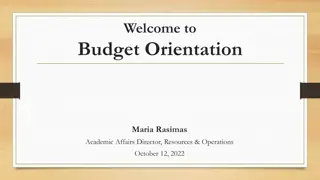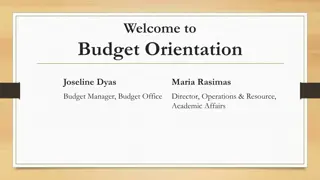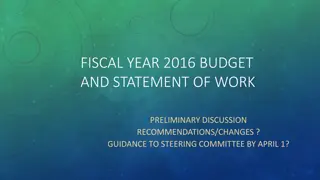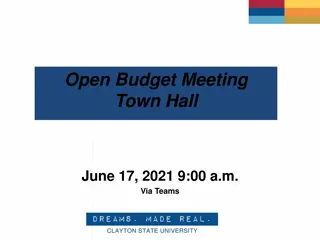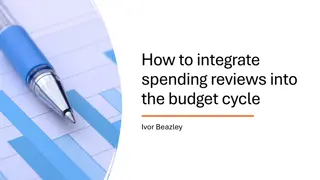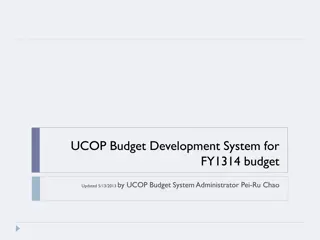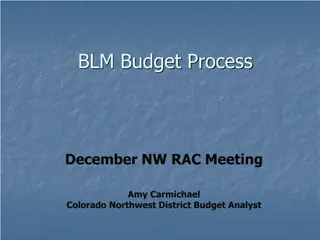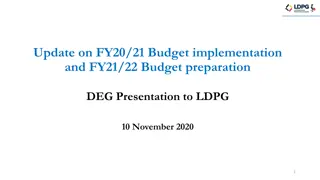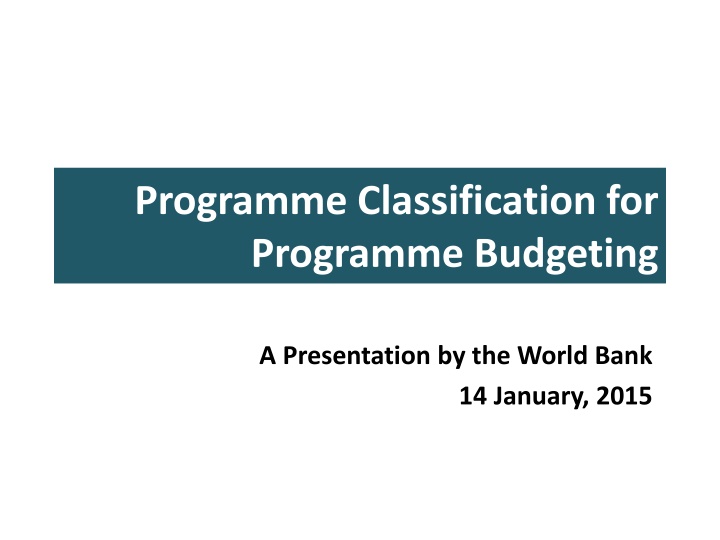
Innovative Programme Classification for Budgeting
Explore the innovative programme classification for budgeting presented by the World Bank in 2015, focusing on features, new segments, guidelines, implementation in various government departments, and future prospects. Discover insights on outcome-based budgeting and challenges in its practical application.
Uploaded on | 0 Views
Download Presentation

Please find below an Image/Link to download the presentation.
The content on the website is provided AS IS for your information and personal use only. It may not be sold, licensed, or shared on other websites without obtaining consent from the author. If you encounter any issues during the download, it is possible that the publisher has removed the file from their server.
You are allowed to download the files provided on this website for personal or commercial use, subject to the condition that they are used lawfully. All files are the property of their respective owners.
The content on the website is provided AS IS for your information and personal use only. It may not be sold, licensed, or shared on other websites without obtaining consent from the author.
E N D
Presentation Transcript
Programme Classification for Programme Budgeting A Presentation by the World Bank 14 January, 2015
Structure of Presentation a. Features of the New Classification Structure b. New Programme Segment what is implies c. Developing guidelines for programme classification basic concepts and practical guidance d. How the programme classification was implemented in 9 GoI department / Ministries e. Way Forward
Rangarajan Report & outcome-based budgeting "[there are] several limitations that impede widespread practical use of the outcome-based budgeting. These include ... Problems in budget and accounting classification" "The minor head is a very critical level and needs an extensive review. There has to be some level of budgeting and accounting that relates to broad objectives of the Government ... to which eventually outcomes can be linked. This would also enable reporting on cost incurred by Government under various items of expenditure for a particular objective and to achieve a desired outcome." "The annual budgeting process may need to be revised to facilitate output and outcome-based budgeting within a multi-year framework."
LMMH NAS Function / Major Head Function / Major Head Function / Major Head 0 & 1 - Revenue receipts 2 & 3 - Revenue expenditure 4000 - Capital Receipts 4 & 5 - Capital Expenditure 6 & 7 - Loans 8000 - Contingency Fund 9000+ - Public Account 1 (Sector) General Services 11 (Sub Sector) Organs of State 1101 Parliament, etc. 8001 Contingency Fund 9101+ - Public Account Sub Function /Sub Major Head Sub Function /Sub Major Head Sub Function /Sub Major Head Program Program Program / Minor Head Scheme Scheme Scheme/ Sub Head Sub scheme Sub scheme / Detailed Head Economic Segment Economic / Object Head
LMMH NAS Function / Major Head Function / Major Head Function / Major Head 0 & 1 - Revenue receipts 2 & 3 - Revenue expenditure 4000 - Capital Receipts 4 & 5 - Capital Expenditure 6 & 7 - Loans 8000 - Contingency Fund 9000+ - Public Account 1 (Sector) General Services 11 (Sub Sector) Organs of State 1101 Parliament, etc. 8001 Contingency Fund 9101+ - Public Account Sub Function /Sub Major Head Sub Function /Sub Major Head Sub Function /Sub Major Head Program Program Program / Minor Head Scheme Scheme Scheme/ Sub Head Sub scheme Sub scheme / Detailed Head Economic Segment Economic / Object Head
LMMH NAS Function / Major Head Function / Major Head Function / Major Head 0 & 1 - Revenue receipts 2 & 3 - Revenue expenditure 4000 - Capital Receipts 4 & 5 - Capital Expenditure 6 & 7 - Loans 8000 - Contingency Fund 9000+ - Public Account 1 (Sector) General Services 11 (Sub Sector) Organs of State 1101 Parliament, etc. 8001 Contingency Fund 9101+ - Public Account Sub Function /Sub Major Head Sub Function /Sub Major Head Sub Function /Sub Major Head Program Program Program / Minor Head Scheme Scheme Scheme/ Sub Head Sub scheme Sub scheme / Detailed Head Economic Segment Economic / Object Head
LMMH NAS Function / Major Head Function / Major Head Function / Major Head 0 & 1 - Revenue receipts 2 & 3 - Revenue expenditure 4000 - Capital Receipts 4 & 5 - Capital Expenditure 6 & 7 - Loans 8000 - Contingency Fund 9000+ - Public Account 1 (Sector) General Services 11 (Sub Sector) Organs of State 1101 Parliament, etc. 8001 Contingency Fund 9101+ - Public Account Sub Function /Sub Major Head Sub Function /Sub Major Head Sub Function /Sub Major Head Program Program Program / Minor Head Scheme Scheme Scheme/ Sub Head Sub scheme Sub scheme / Detailed Head Economic Segment Economic / Object Head
Minor Heads (and Schemes) in LMMH were not mutually exclusive For example: Minor Head 102 Is In 2055 Police CRPF 2056 Jails Jail Manufacture 2080 DRDO Civilians 2202-01 General Education Assistance to non-govt. primary schools 2204 Sports & Youth Affairs Youth Welfare programs for students Some common Minor heads are 001 D&A OO3 Training 004 Research & Education 800 Other Expenditure
Function / Major Head Sub Function /Sub Major Head Has been left open for Budget Division to Develop Program Scheme Sub scheme Economic Segment
Function / Major Head Sub Function /Sub Major Head Has been left open for Budget Division to Develop Program First digit to indicate type of scheme including source of funding: 0- receipt; 1-CS Schemes; 2- CSS; 3- CA for State Plans; 4-5 State Plans; 6-7 Reserved; 8-Non-plan. Schemes are globally serially numbered A scheme would have same number with different first digit across central and state governments E.g. Sarva Shiksha Abhiyan would be 21479 in central government and state budget / accounts as a CSS 41479 in state government to show state share 81479 in central and state budgets / accounts to show non plan There are some generic schemes such as D&A 11001/41001/81001 Scheme Sub scheme Economic Segment
Function / Major Head Sub Function /Sub Major Head Has been left open for Budget Division to Develop Program First digit to indicate type of scheme including source of funding: 0- receipt; 1-CS Schemes; 2- CSS; 3- CA for State Plans; 4-5 State Plans; 6-7 Reserved; 8-Non-plan. Schemes are globally serially numbered A scheme would have same number with different first digit across central and state governments E.g. Sarva Shiksha Abhiyan would be 21479 in central government and state budget / accounts as a CSS 41479 in state government to show state share 81479 in central and state budgets / accounts to show non plan There are some generic schemes such as D&A 11001/41001/81001 Scheme Sub scheme 1. Revenue Receipts 2. Capital Receipts 3. Recurrent Expenditures 4. Capital Expenditures 5. Liabilities Economic Segment 31 - Employee Compensation 311- Salaries
What are the new segments? Administrative Segment Recipient Segment Target Segment Geographic Segment
What are the new segments? 31 Ministry of Personnel, PG, etc. 311 Dept. of personnel 31101 Secretariat Administrative Segment Recipient Segment Target Segment Geographic Segment
What are the new segments? 31 Ministry of Personnel, PG, etc. 311 Dept. of personnel 31101 Secretariat Administrative Segment Recipient type AB, PSUs, etc. Recipient Number 10 Autonomous Bodies 000003 - AIIMS Recipient Segment Target Segment Geographic Segment
What are the new segments? 31 Ministry of Personnel, PG, etc. 311 Dept. of personnel 31101 Secretariat Administrative Segment Recipient type AB, PSUs, etc. Recipient Number 10 Autonomous Bodies 000003 - AIIMS Recipient Segment 001 Women 002 - SC Target Segment Geographic Segment
What are the new segments? 31 Ministry of Personnel, PG, etc. 311 Dept. of personnel 31101 Secretariat Administrative Segment Recipient type AB, PSUs, etc. Recipient Number 10 Autonomous Bodies 000003 - AIIMS Recipient Segment 001 Women 002 - SC Target Segment Special Areas States Districts Geographic Segment Local Bodies i.e. PRIs and ULBs; they shall have the same code as in recipient segment
Programmes, functions and the budget Current position: Each function broken into minor heads ( programmes ) Programmes are subordinate to functions Programmes represent quite detailed classification of spending Sundaramurti: programmes independent of functions Programmes as broad categories of spending Big picture government-wide spending priorities Higher-level than current minor heads Consistent with international practice Functions (COFOG) not in the budget classification Programmes specific to DDGs Reflecting budget authority of each DDG
Budgeting for Results Chart of Accounts Major / Sub Major Head Functional (COFOG) Line Item Budget Department / Ministry Outcome Budget Programme Budget Programme Scheme Budget Classification Accounting Results Framework Document Economic, Administrative, Recipient, Geographic, Target NOW Going Forward
New Programme Segment Programmes no longer parts of functions Programme to which a scheme belongs doesn't depend upon function to which it belongs Programmes different from current minor heads Programmes defined on the basis of key policy objectives of the department/ministry Tool for future outcome-based budgeting Performance management (RFD) linked to budget programme budgeting system
Programmes & Key Policy Objectives Programmes are groups of services (outputs) Groups of schemes in the Indian context Which have a common policy objective What is known as an outcome Specific type of positive change Already the basis of the RFD
Programme objectives are programme-specific outcomes Primary education programme objective: Educated and socialized children Higher-level outcomes of education are: Strong economy, social harmony, etc Higher-level outcomes not programme specific Shared by many programs
Programme Budgeting Internationally, programmes are the basis of programme budgeting systems Budgeting on a programme basis E.g. DDGs based on allocations to each program Programmes cover all expenditure Capital and recurrent; ongoing and temporary projects Programmes as expenditure planning instrument Deciding expenditure priorities Programmes as focus of performance accountability Objectives & performance indicators for each program Performance examined during budget preparation
Guidelines the background Principles to guide definition of programmes To ensure common approach across whole GOI & states Consistent with Sundaramurti Committee principles Easily understood principles Ministries/departments can own the process of programme development Principles recognize Indian administrative structures Budgetary autonomy of DDGs
Principle of Results-Based Programmes Programmes must be defined as groups of services delivered to clients external to the department (i.e. "outputs"), which have a common intended outcome E.g. Agricultural Cooperation, Marketing & Statistics programme Outcome: farmers have access to credit and are able to efficiently market their production Outputs (services): marketing services, support for cooperatives, export quality assurance system, etc Services delivered to citizens, and objective of providing those services
Exceptions to Results-Based Principle Administration and General programmes (AGPs) All cross-programme internal services provided by one part of the department to another part of the same department. AGPs deliver support services, which are not outputs programme not based on output or outcomes Avoid the complexities of cost allocation Only one AGP per department Government Coordination and Support programmes Services which one department provides to another part of government E.g. Public Works Dept construction for other departments These services are outputs, but GCSPs don t have outcomes Some comment on GCSP principle: will be further examined
Programme Hierarchy Programme Sub-Programme Sub-programme Sub-programme Scheme Scheme Scheme Scheme Scheme Scheme
Sub-Programmes: South African Example Programme 2 Agricultural Production, Health and Food Safety Sub-Programme 4 Animal Inspection & Laboratory Sub-Programme 3 Plant AgriculturalResearch Production & Health Production & Health Sub-Programme 2 Sub-Programme 5 Sub-Programme 1 Administration Services
Sub-Programmes: Indian Example Programme Agricultural Production & Farm Incomes Agricultural Extension & Sustain. Agriculture & Security of Farmers Sub-Programme 4 Welfare & Income Sub-Programme 5 Sub-Programme 2 Sub-Programme 1 Sub-Programme 3 Micro Irrigation Food Security Development Horticulture Technology
Programmes & Outcomes Overall outcome (objective) defined for each programme Australian Ministry of Health and Ageing Programme1: Population Health A reduction in the incidence of preventable mortality and morbidity in Australia, including through regulation and national initiatives that support healthy lifestyles and disease prevention.
Outcomes Desired impacts of services: Upon the individuals, social structures, or physical environment Examples: Improved health of patients Conservation of natural environment Effectiveness an outcome concept High-level vs Intermediate outcomes Impact used by some for high-level outcomes Intermediate Outcome High Level Outcome Output 30
Key Performance Indicators linked to programmes Requirement to define KPIs for each programme and/or sub-programme Indicators of results delivered to the public Programme outcomes Programme outputs
South African Example Key Indicators for the University Education programme Number of students enrolled in higher education institutions per year Proportion of higher education enrolments in science, engineering and technology Number of higher education graduates per year
Outputs & Inputs Outputs = products But in government, most are services, not goods Services to external client or subject Client outside the ministry/department Not a service to an internal client Examples of outputs: A school student who receives teaching A patients treated in a public hospital Benefit payment administered Enforcement of legislation Inputs Resources used to produce outputs 33
Activities (processes) Activities produce outputs Support activities human resources, IT ... Direct service activities nursing Processes: sequence of activities Activity indicators Job vacancies filled Pension applications processed Activities are not outputs Not capable alone of delivering outcome Quantity, quality and efficiency measures 34
The Results Chain High-level OUTCOMES Intermediate OUTCOMES OUTPUTS ACTIVITIES/ PROCESSES INPUTS 35
Preventative Health Programme Outcome: prevention of disease and injury. Outputs (services) possibly included: sanitation promotion publicity campaigns; anti-diabetes television ads; anti-smoking pamphlets distributed in public health clinics; visits of nurses to schools to talk to children about healthy eating practices; the placement of notices warning people against swimming or washing in lakes or rivers with waterborne diseases; and the spraying of water sources which breed malaria-carrying mosquitoes, etc .. All of these outputs work towards a common outcome
Programme title & objective Title: short, type of service Primary education , Agriculture etc Objective should usually be outcome: Key result the programme seeks Canada Dept Environment Nature Program: The conservation of biological diversity in healthy ecosystems Several exceptions (discussed later) Objective will often cover more than outcome E.g. type of client targets; mode of intervention
Objective: wrong approaches Objective is not the output: Provision of medical assistance to persons in an emergency Objective is not the bureaucratic activity: Manage the development, implementation, evaluation and maintenance of national policy, programmes and systems for general education and quality assurance Doesn t say what purpose is: Not client or results-focused No use for priority-setting
Programme Objectives from Pilots Ministry of Power PROGRAMME Administration and General OBJECTIVE Providing efficient and effective support and coordination including policy and regulatory framework Access to electricity to all villages and rural households Reliable, adequate and quality power at reasonable prices Rural Electrification Electrification
Programme objectives are not targets Formulated in general way with enduring relevance Not as quantifiable target Which is only relevant until it is achieved Rural Electrification programme example Programme objective is: Access to electricity to all villages and rural households Not "95% of rural households to be linked to power supply" Programme objectives remain relevant for years Don't need to be changed every couple of years Indicators and Targets set separately
Objectives also for Sub-Programmes PROGRAMMES SUB-PROGRAMMES OBJECTIVES Elementary Education Produce educated and properly socialised children Universalization of Elementary Education Produce educated and properly socialized children Nutrition Support to Children Enhance learning, enrolment and retention of children through proper nutrition
How to Identify Programme Outcomes Results Framework Document can be useful Look at Section 6 (Outcome/impact); and at Objectives section Dept Agriculture & Cooperation a good example -- outcomes/impacts are Increased agricultural production Increased horticulture production Increased investment in agriculture Improved growth of agriculture sector Improved economic well-being of farmers and reduction in rural poverty But don't just copy these outcomes Programme outcomes must be programme-specific
Identifying Programme Outcomes RFD outcomes/impacts sometimes badly specified Department of School Education example Improve access to education . The Kasturba Gandhi Balika Vidyalaya (KGBV) scheme, provides for setting up of residential upper primary schools for girls from SC, ST Mid Day Meal Scheme None of these are outcomes Outcome budget documents also useful List of scheme objectives/outcomes worth looking at.
Exceptions to Results-Based Principle Two types of programmes without program- specific outcomes Administration and General Programs Government Coordination and Support programs
Process of Developing Programme Classification Step One: a. List schemes as per DDG to understand the range of activities of the department ..\..\Presentations\DAC Pilot - 1.docx
Process of Developing Programme Classification Step Two: a. If the schemes have since been rationalized / consolidated, then arrange them under the revised list ..\..\Presentations\DAC- rationalized consolidated schemes.docx
Process of Developing Programme Classification Step Three: a. List the existing minor heads b. List the outcomes as given in the Outcome Budget and Results Framework Document (RFD) c. Examine: To what extent the existing groupings under the minor heads reflect programs in terms of aggregate outcomes It may be necessary in some cases to deliberate on the outcomes as given in RFD as they might actually be an output or even an activity ..\..\Presentations\DAC - Outcomes as per RFD.docx
Process of Developing Programme Classification Step Four: a. Arrive at well thought out list of outcomes for which the department is responsible b. As the outcomes would typically serve as the basis for defining programmes, derive a fresh list of programmes c. Large departments / ministries tend to have larger number of schemes; in such cases, design sub programmes to group schemes that might be responsible for intermediate outcomes d. Group the schemes suitably under the new list of programs / sub programmes which result in aggregate outcomes ..\..\Presentations\DAC-Programmes_Sub Programmes.docx
Process of Developing Programme Classification While developing the programme classification, keep the following key principles in mind: a. Expenditure on a programme should be at least 0.5% of total government expenditure b. The programme title should be short and informative. It should make as clear as possible the type of services and intended outcome of the programme c. Programs should not be simply derived from the internal organizational structures of ministries/departments. The defining principle of programs is common outcomes and not common management.
Process of Developing Programme Classification d. If there are two or more programs, create an additional Administration & General program to cover all schemes which support multiple programs and which cannot therefore be assigned to any single program; conversely if a department has only one programme, there will be only one program and no A&GP e. If there is a programme under which the department delivers outputs to other departments or ministries or to government as a whole, a Government Coordination and Support Programme (GCSP)

